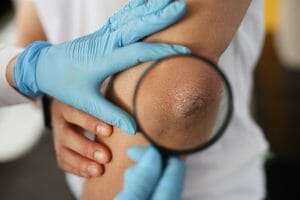World Psoriasis Day
- Posted on: Oct 6 2021

To celebrate World Psoriasis Day on October 29th, the team at Asarch Dermatology is raising awareness about this common skin condition which affects millions worldwide. Gaining a better understanding of the disease can help those affected lead healthier, happier lives. Take a closer look at the symptoms, types, causes, and treatments for this chronic skin condition and how it compares to another common skin problem, eczema.
Types of Psoriasis
Knowing which type of psoriasis you have allows you and your dermatologist to form an effective treatment plan. Here’s how to identify the most common types of psoriasis:
- Plaque: As the most common type, plaque psoriasis causes red, inflamed skin that is covered in white, silvery scales. You’ll notice these raised, red patches on your knees, elbows, scalp, and lower back.
- Guttate: This type is common in children and young adults, and it causes small, round, reddish-pink spots to appear on your skin. They usually develop on the legs, arms, torso, and scalp.
- Inverse: Signs of inverse psoriasis include patches of inflamed, bright red skin that are smooth and without scales. It affects the body’s skin folds, including under the breasts, arms, buttocks, and genitals.
- Pustular: As the name implies, this type results in blisters or pus-filled bumps, and the surrounding skin is red and inflamed. The bumps might only affect the palms or soles of your feet, or they can affect most areas of the body.
- Erythrodermic: The erythrodermic type of psoriasis is rare, but it’s a serious and life-threatening condition that requires immediate psoriasis treatment. It causes your skin to look burned, creates a burning sensation, and appears as a red, peeling rash that covers most of the body.
- Psoriatic: This condition causes tender, swollen, and painful joints, especially in the fingers and toes. Without treatment, permanent joint damage can occur.
How to Tell the Difference Between Psoriasis and Eczema
Neither of these skin conditions is contagious, but it can be difficult to tell the difference between them. Here are the key similarities and differences between these two common skin problems.
Are Psoriasis Causes Different From Those Associated With Eczema?
Psoriasis is an autoimmune disease that increases your risk of developing many other conditions, including eye conditions like conjunctivitis and blepharitis, and other autoimmune diseases, such as inflammatory bowel disease, celiac disease, and multiple sclerosis. It causes your skin cells to grow too fast. This rapid buildup of skin cells causes them to accumulate on the surface of the skin, leading to thick, scaly lesions and red patches.
The cause of eczema isn’t well understood, but experts believe that a combination of environmental and genetic factors plays a role in its development.
Differences in Itchiness
These two skin conditions also have subtle differences in the intensity of itching they cause. While psoriasis causes some mild itching, your skin is more likely to sting or burn. If you have eczema, you’re more likely to experience intense itching. This severe itch can affect your ability to sleep and can become so severe that you might scratch your skin so hard that it bleeds.
What Symptoms Should You Watch Out For?
Although both skin diseases cause similar symptoms, there are ways to tell them apart. Red, scaly patches that are well-defined and have silvery-white scales are some of the most common psoriatic symptoms. The skin is often thicker in comparison to eczema and appears more inflamed. Nail changes are also common, causing yellow-brown nails, pitting, and crumbling nails that may separate from the nail bed.
While eczema also causes red, inflamed skin, you’re more likely to experience rough, leathery patches of skin that may appear crusty or scaly. The skin is intensely itchy, and there might also be some swelling.
How Is Psoriasis Treatment Different Than Treatment for Eczema?
Although the causes and symptoms for both of these skin conditions are different, the treatment options are similar. These include:
- Topical corticosteroids to reduce inflammation and minimize swelling and redness
- Topical treatments to soothe and moisturize the skin
- Prescription medications that decrease inflammation by controlling the immune system response
Psoriasis treatment also includes exposure to natural ultraviolet B (UVB) light from the sun, which can reduce the abnormal growth of skin cells as it penetrates the skin. If you have eczema, the heat from the sun can make your skin more sensitive, which can trigger a flare-up of symptoms.
If you’re struggling with red, dry, or itchy skin, the skin care experts at Asarch Dermatology are here to help. We provide comprehensive and compassionate care for all skin conditions, and we’ll help you explore available treatment options for long-term disease management.
